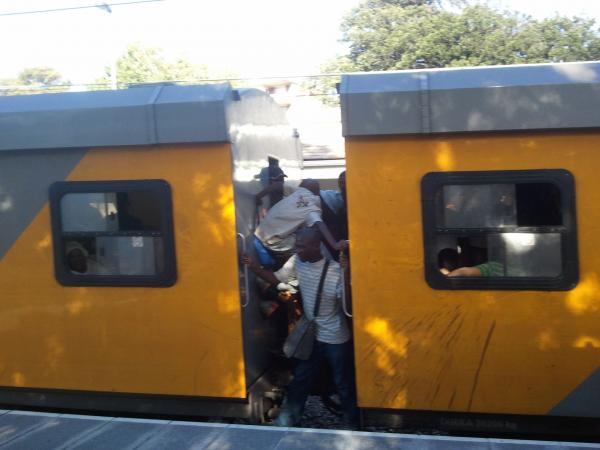

Commuters riding between carriages.
4 July 2012
Modern cities need transport systems that are safe, affordable, reliable, extensive and easy to understand.
Public transport should be available twenty-four hours a day, seven days a week. People in the poorest suburbs should be able to commute easily to work and back. However, they should also be able to get to tourist destinations, so they can have a stake in the heritage of their cities.
Many of the world’s major cities have already achieved this. Even many developing country cities in South America, Eastern Europe and Asia have great public transport systems, but South Africa’s cities have a very long way to go.
As the articles in this issue of GroundUp show, Cape Town’s transport system is very poor. Minibus taxis are affordable, but they are dangerous, chaotic, unreliable and uncomfortable. Commuters frequently complain about rude and violent taxi drivers.
While the city has an extensive rail system, it has fallen into disrepair. Carriages look like graffitied walls. The train service regularly breaks down. The distinction between Metro Plus (1st class) and Metro (3rd class) is an apartheid relic that must be banished. People ride the system without paying. At rush hour the trains are so full it is often impossible to board them. And commuters often stand between carriages so they can either get on a full train, or avoid paying their fare (see photo).
The Golden Arrow bus system is a mixed bag. Some routes are extremely efficient, regular, safe and reliable, but many are not. Some routes are simply bizarre: as one of our articles explains, an often empty bus travels to Kirstenbosch from the city once a day.
We haven’t included an article in this issue on how difficult it is to get to Cape Town’s premier tourist destinations because we want to compete with Getaway magazine. The majority of Cape Town’s residents have probably not visited our wonderful natural tourist sites, like Kirstenbosch and Cape Point. If they have an interest in the future preservation of these places, surely it should be affordable and easy to visit them on public transport? And no, a once-daily bus to Kirstenbosch that apparently does not return, does not count.
If you’re new to the city, or even if you simply move to a new home, it’s a mighty challenge to work out how the various transport systems work. There is no single map, as far as we are aware, describing Cape Town’s transport routes. Wheelchair-bound or blind residents have very few public transport options.
There is good news and hope though: The MyCiTi bus rapid transport system is a great success. At the moment, it serves primarily middle-class areas, but by September 2013, it will be running to Atlantis, Du Noon and Joe Slovo Park. Following that, it will be rolled out to Mitchells Plain and Khayelitsha. Then it will roll out to Bellville, Delft and Stellenbosch.
As our interview with Mayco member Brett Herron shows, the City —and Herron in particular— is serious about fixing transport in the city. Besides extending the MyCiTi, there are efforts to bring all the modes of transport under one authority and integrate them. There is also a desire to improve the rail system. There will no doubt be many hurdles. Vested interests in the minibus taxi industry as well as the private bus services will throw up many obstacles. No doubt petty party-political squabbling will also get in the way. But so long as there is political will and public pressure, Cape Town’s transport system can improve.
It should be possible to imagine a Cape Town where you can one day seamlessly hop on a train to the city from Khayelitsha on a Saturday evening. You pay using a smart card, then in the city, switch to a bus to the Waterfront using the same smart card. At the Waterfront, you can watch the late-night movie, and then, without having to worry about safety or delays, can catch the 00:07 bus back to the train station, catch the 00:29 train back to Khayelitsha, and then take a late-night feeder bus that leaves at precisely 01:16 straight to your door. And all of this in the comfort of your wheelchair. Not until this is possible, will our transport system have truly arrived.